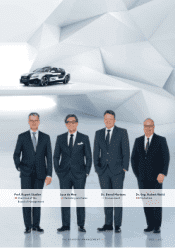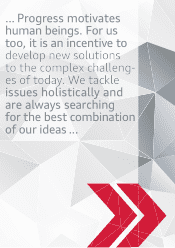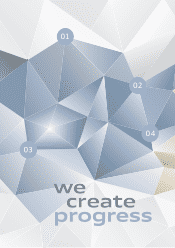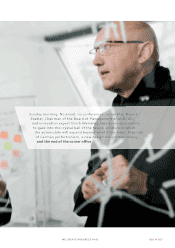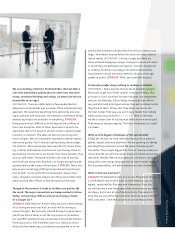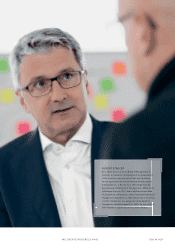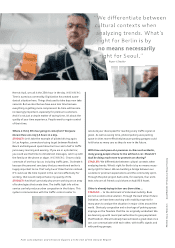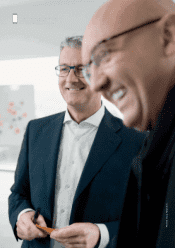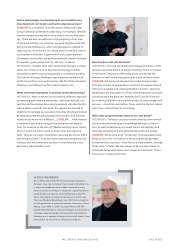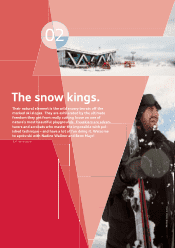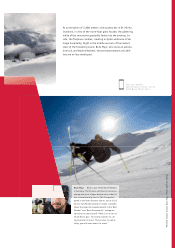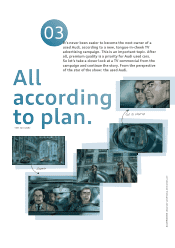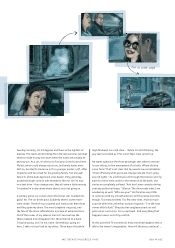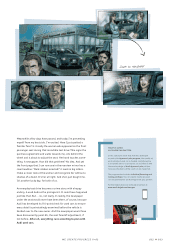Audi 2014 Annual Report Download - page 22
Download and view the complete annual report
Please find page 22 of the 2014 Audi annual report below. You can navigate through the pages in the report by either clicking on the pages listed below, or by using the keyword search tool below to find specific information within the annual report.
Future technologies are developing at an incredible pace.
How important is it to also work with external partners ?
STADLER : It is essential. Audi Electronics Venture and the
Group’s Electronics Research Laboratory, for example, identify
trends in entertainment electronics and join forces with start-
ups. There are also innovations on the periphery of our area
of business activity. For instance, we work together with the
Swiss startup Climeworks, which has developed a method of
capturing CO from the air. It is being used for the fi rst time in
a pilot plant in Dresden. Together with our project partners
Climeworks and sunfi re, we produce synthetic diesel fuel there
from water, green power and CO. We call it e-diesel.
WEINBERG : Collaboration with universities will gain in impor-
tance, too. There is more to this than technology transfer.
Universities need to train young people in connected working.
The School of Design Thinking brings together students and
professionals from various disciplines. We fi nd that connected
thinking is something they fi rst need to learn to do.
What motivates employees to practice connected working ?
WEINBERG : New incentives and an entirely di erent approach
to assessing performance are needed. Until now, schools, uni-
versities and businesses have mainly assessed individual perfor-
mance within a specifi c discipline. So people have tended to
treat their knowledge as a private commodity. We should instead
be rewarding interdisciplinary team performance. And fi nancial
incentives alone are not su cient … STADLER : … what matters
is creative scope, and once again the new premium asset of
time, for example in the form of fl exible working hours. Gener-
ations Y and Z are less focused on hierarchies and organiza-
tions. They are no longer interested in securing the corner o ce
with the good view. The brain power that every employee con-
tributes, and not someone’s position in the hierarchy, must
determine who benefi ts most.
Does the boss still call the shots ?
WEINBERG : Here we are standing at hexagonal tables, of the
type we use at the School of Design Thinking. There is no head
of the table. Everyone is e ectively a boss and senses the
freedom as well as the obligation to be a part of the solution.
STADLER : We have just adopted new leadership principles
that give primacy to appreciation and trust. It revolves around
setting an example and creating freedom of action. Inspiring
leadership puts employees in control where teamwork and open
communication are practiced. Between and we will
be investing billion euros in new products, techno logies and
services – more than ever before. There could hardly be a clearer
sign of our commitment to innovating.
What does progressiveness mean in our new world ?
WEINBERG : The key to success involves tearing down mental
barriers and maximizing your knowledge through collabora-
tion, as well as delivering a concept that is emotionally and
rationally satisfying and also demonstrates premium quality.
STADLER : We use the word “Vorsprung” to encapsulate every-
thing we strive for. Innovation is the principle that pervades
every area of our business – from Technical Development, through
Production, to Sales. We aim always to be one step ahead, to
anticipate today what tomorrow’s customers will want. That is
how we are creating tomorrow.
ULRICH WEINBERG
Born 1958 ; Head of the HPI School of Design Thinking in
Potsdam, the sister institute of the d.school in Stanford. This
is where he collaborates with students and professionals
to come up with innovations in response to specifi c problems
encountered by companies. Ulrich Weinberg has been Pro-
fessor of Computer Animation at the University of Film and
Television Potsdam/Babelsberg since 1994 ; he has taught as
a visiting professor at the Communication University of China,
Beijing, since 2004. In 2007, he joined forces with SAP
founder Hasso Plattner to set up the European d.school and has
since been exporting design thinking to China and Malaysia.
Weinberg was a member of the jury for the Audi Urban Future
Award 2014. He lives with his wife and son in Berlin.
022 >> 023WE CREATE PROGRESS >> 01


